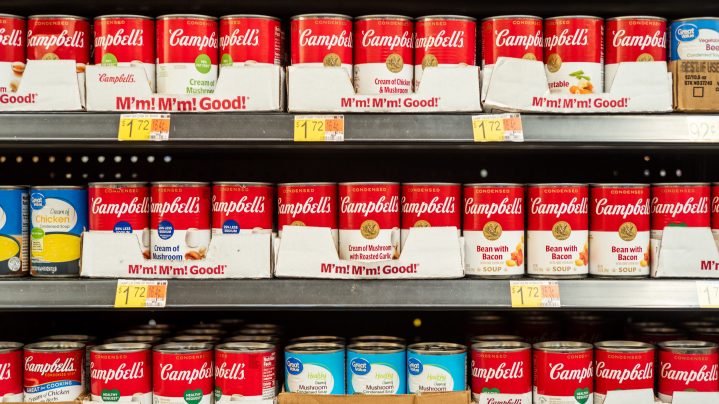
Consumers turn to cheaper packaged foods — even at higher new prices — for inflation relief
Consumers turn to cheaper packaged foods — even at higher new prices — for inflation relief

This week, the Campbell Soup Company said its sales rose 15% last quarter, compared to the same time last year. That’s despite selling fewer cans of soup — the company’s sales volume actually fell by 1%.
The inescapable conclusion here is that Campbell’s has jacked up the prices of its soups, pasta sauces and snacks. And it’s pretty hard to avoid paying higher prices when we’re talking staple groceries.
Whenever John Stanton’s walked down supermarket aisles this year, he said it’s been hard to miss higher prices on packaged foods. “It’s noticeable. And I walk through the supermarkets regularly.”
Stanton does that because he’s a professor of food marketing at St. Joseph’s University and a former consultant to the Campbell Soup Company.
It’s not just packaged foods that are getting more expensive, he said. “It’s buffered by the fact that not only are these packaged goods going up, but it seems like everything’s going up.”
Produce, meat, dairy — even going out to eat.
Amy Bentley, a professor of food studies at NYU, just went out to a lunch spot to buy herself some hot soup.
“And a small container was like $6,” she said. “You know, at some point I’m thinking, ‘Can I really justify buying that container of soup for my lunch if it’s way more than I’m comfortable spending?'”
And that’s exactly the kind of thought that makes Campbell’s soups and other packaged goods look a lot more attractive. “Because it’s seen as an economy food, and it’s shelf stable, and it’s something that Americans have relied on for a long time,” Bentley said.
People could trade down further and buy generic or private-label foods, said Erin Lash, an analyst at Morningstar. But there’s a kicker: “Consumers that trade down are still paying a higher price than what they would have over the past year,” she said.
Food companies’ input costs have been rising, too. Campbell’s says its costs were up 18% last quarter. Packaged food companies are likely to keep prices high, Lash said, since their costs are also likely to stay high.
“Some of that tends to be more sticky,” she added, “meaning that if you’ve put through wage increases, those are unlikely to be rolled back.”
Next year, Lash expects packaged food companies to focus on offering multiple products at different price points, so that people have cheaper options.
There’s a lot happening in the world. Through it all, Marketplace is here for you.
You rely on Marketplace to break down the world’s events and tell you how it affects you in a fact-based, approachable way. We rely on your financial support to keep making that possible.
Your donation today powers the independent journalism that you rely on. For just $5/month, you can help sustain Marketplace so we can keep reporting on the things that matter to you.

















